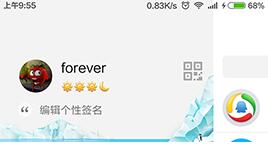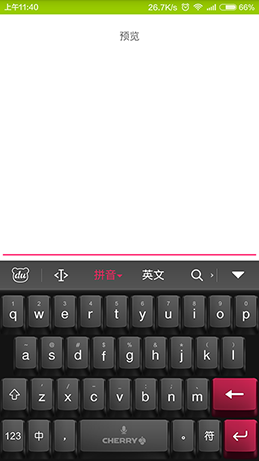关于沉浸式状态栏相信大家都不陌生,ios系统很早就有,android5.0及以后版本都支持给状态栏着色,而目前android主流版本还是4.4,网上通用实现4.4(api19)沉浸式状态栏也都是依赖于可以将状态栏变为透明的属性,再为其着色,主要实现代码:
|
1
2
3
4
5
6
7
8
9
10
11
12
13
14
15
16
17
18
19
20
21
22
23
24
25
26
27
|
@override protected void oncreate(bundle savedinstancestate) { super.oncreate(savedinstancestate); setcontentview(r.layout.activity_match_actionbar); //只对api19以上版本有效 if (build.version.sdk_int >= build.version_codes.kitkat) { settranslucentstatus(true); } //为状态栏着色 systembartintmanager tintmanager = new systembartintmanager(this); tintmanager.setstatusbartintenabled(true); tintmanager.setstatusbartintresource(r.color.statusbar_bg); } @targetapi(19) private void settranslucentstatus(boolean on) { window win = getwindow(); windowmanager.layoutparams winparams = win.getattributes(); final int bits = windowmanager.layoutparams.flag_translucent_status; if (on) { winparams.flags |= bits; } else { winparams.flags &= ~bits; } win.setattributes(winparams); } |
再在根布局添加以下两个属性:
|
1
2
|
android:fitssystemwindows="true"android:cliptopadding="false" |
这样就可以了,以上着色使用了systembartint。
为什么我要寻找其他的方案?
面对大多数的界面自然是没有多大问题,但是针对类似qq这种侧滑的界面,如图:

我的手机系统版本是4.4的,如果想做成qq侧滑背景这样的效果,使用上面的方案就变成了这样

这样出来的效果就会很丑,于是才有了改进版的方案,不知qq是否是这样做的。
除了上述的缺陷以外,还有一点看着不是很舒服,就是当我使用抽屉菜单或者滑动返回效果的时候是这样的

状态栏并没有阴影效果
我想要的效果是这样的

状态栏也会跟着一起滑动
第一种思路
自定义一个状态栏,不能添加“ android:fitssystemwindows="true"
”这个属性,不然无法填充到状态栏,如下
|
1
2
3
4
5
6
7
8
9
10
11
12
13
14
15
16
17
|
<?xml version="1.0" encoding="utf-8"?><linearlayout xmlns:android="http://schemas.android.com/apk/res/android" android:layout_width="match_parent" android:layout_height="match_parent" android:background="@color/coloraccent" android:orientation="vertical"> <view android:id="@+id/status_bar" android:layout_width="match_parent" android:layout_height="20dp"/> <framelayout android:layout_width="match_parent" android:layout_height="match_parent"/></linearlayout> |
在到代码中判断
|
1
2
3
4
5
6
7
8
9
10
11
12
13
14
15
16
17
18
19
20
21
22
23
24
25
26
27
|
@overrideprotected void oncreate(bundle savedinstancestate) { super.oncreate(savedinstancestate); view statusbar = findviewbyid(r.id.status_bar); setcontentview(r.layout.activity_test); //判断sdk版本是否大于等于19,大于就让他显示,小于就要隐藏,不然低版本会多出来一个 if (build.version.sdk_int >= build.version_codes.kitkat) { settranslucentstatus(true); statusbar.setvisibility(view.visible); //还有设置view的高度,因为每个型号的手机状态栏高度都不相同 }else{ statusbar.setvisibility(view.gone); }}@targetapi(19)private void settranslucentstatus(boolean on) { window win = getwindow(); windowmanager.layoutparams winparams = win.getattributes(); final int bits = windowmanager.layoutparams.flag_translucent_status; if (on) { winparams.flags |= bits; } else { winparams.flags &= ~bits; } win.setattributes(winparams);} |
其实,这样已经解决了我上面提出的两个问题
第二种实现方案
第二种方案是为了解决第一种方案中遇到的奇葩问题,设置了透明属性的界面(聊天及底下评论的框框)不能被系统输入法顶上去,之前写过一篇android 聊天界面背景图片被输入法“顶上去”问题解析,现在遇到的就是无论如何聊天的输入框都不能被系统输入法顶上去(就是打字看不到输入框),经过一番测试,发现竟然和“ android:fitssystemwindows="true"
”这个属性有关,加上去输入框就没问题,但自定义的状态栏不能被填充到真正的状态栏位置

陷入了两难的境地,加还是不加都有问题,而且都特别明显,说了半天,来看看第二种方案。
|
1
2
3
4
5
6
7
8
9
10
11
12
13
14
15
16
17
18
19
20
21
22
23
24
25
26
27
28
29
30
31
32
33
34
35
36
37
38
39
40
41
42
|
<?xml version="1.0" encoding="utf-8"?><relativelayout xmlns:android="http://schemas.android.com/apk/res/android" xmlns:tools="http://schemas.android.com/tools" android:layout_width="match_parent" android:layout_height="match_parent" android:background="@android:color/holo_green_light" android:fitssystemwindows="true" tools:context="com.saidtx.myapplication.testactivity"> <scrollview android:layout_width="match_parent" android:layout_height="match_parent" android:layout_above="@+id/edit" android:background="@android:color/white"> <linearlayout android:layout_width="match_parent" android:layout_height="wrap_content"> <textview android:layout_width="match_parent" android:layout_height="wrap_content" android:gravity="center" android:padding="20dp" android:text="@string/previews"/> </linearlayout> </scrollview> <linearlayout android:id="@+id/edit" android:layout_width="match_parent" android:layout_height="wrap_content" android:layout_alignparentbottom="true" android:background="@android:color/white"> <edittext android:layout_width="match_parent" android:layout_height="wrap_content"/> </linearlayout></relativelayout> |
关键在于下面两个属性,还有需要在其他子布局添加背景,不然就跟随了最外层的背景,代码部分还是采用网上通用方案,只是不需要自定义的状态栏了,也不需要计算状态栏的高度
|
1
2
|
android:fitssystemwindows="true"android:background="@android:color/holo_green_light" |
最终效果

以上就是本文的全部内容,希望对大家的学习android软件编程有所帮助。
















